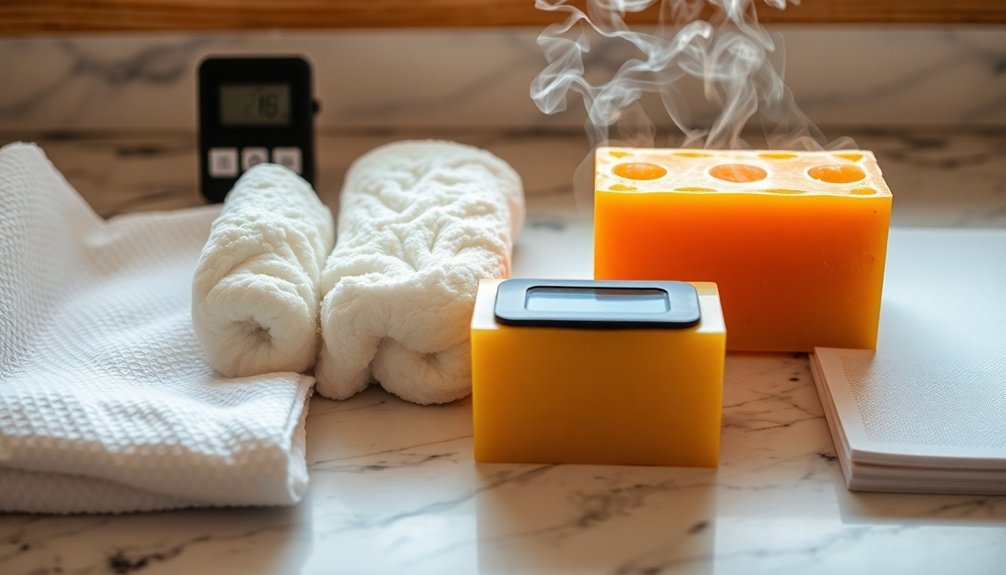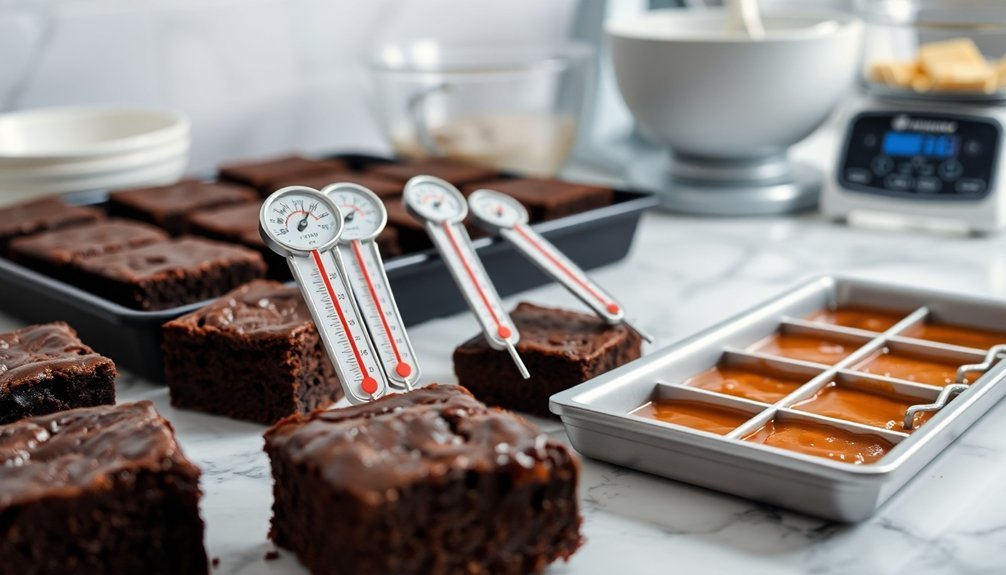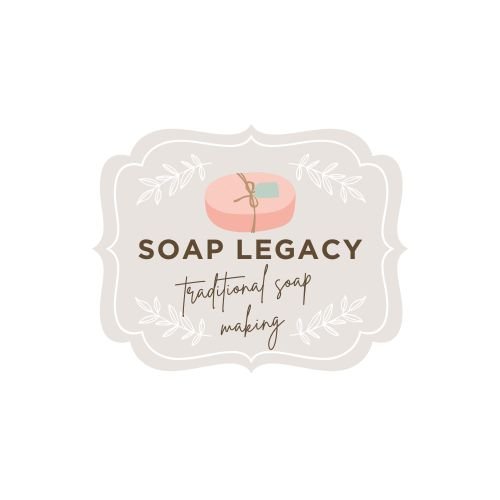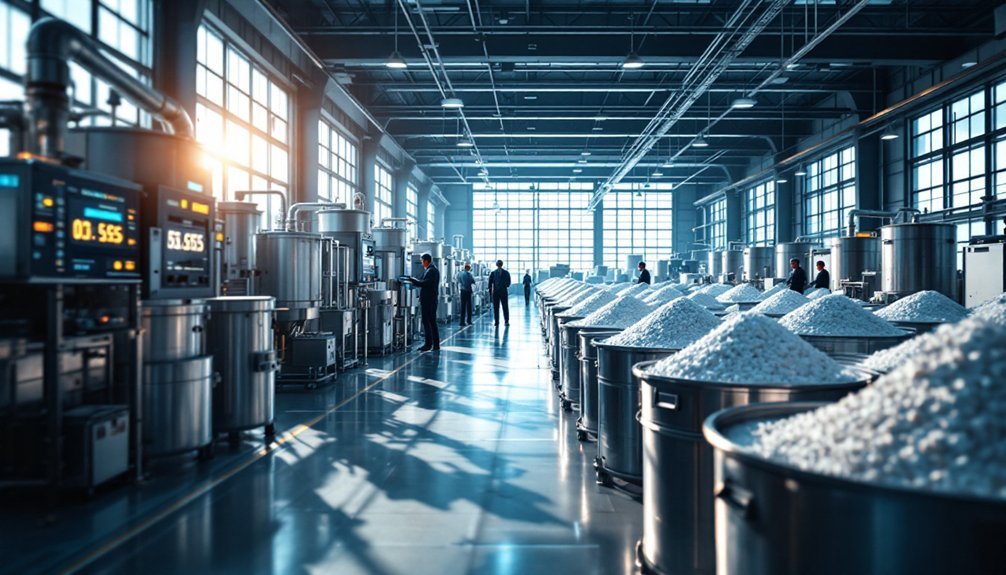Managing soap temperatures is essential for premium bars. You'll get better results by using insulation materials like styrofoam or wool, monitoring the exothermic reaction (60-71°C ideal), employing digital thermometers for precision, working with larger batches that retain heat longer, and controlling your curing environment (70-85°F with 40-60% humidity). These temperature-control techniques transform soft, inconsistent soap into hard, professional-quality bars. Discover how each method impacts your final product.
Optimal Insulation Materials for Soap Molds

While many soapmakers focus on ingredients and molds, proper insulation remains one of the most overlooked factors in creating perfect bars. Choosing the right insulation materials dramatically impacts heat retention during saponification, resulting in smoother, more consistent soap.
Styrofoam and specialized insulated boxes offer excellent temperature control, but don't overlook natural alternatives like wool or fleece. These materials maintain ideal temperatures throughout the gel phase, preventing thermal shock that causes cracks and imperfections.
Consider thickness when selecting your insulation – thicker layers generally provide better heat retention for a controlled curing environment.
For eco-conscious crafters, recycled cardboard and fabric wraps work surprisingly well while remaining sustainable and economical options.
The right insulation transforms good soap into exceptional bars by creating the perfect thermal environment for saponification.
Managing Heat Phases During Saponification

Understanding heat management represents the difference between professional-quality bars and mediocre results. The exothermic reaction between lye and fats can reach 160°F, and monitoring this heat is the most important thing you'll do during soap making.
When your mixture approaches the ideal 60°C-71°C range, you'll need to intervene strategically. Place your container in an ice bath if temperatures climb too high, or use cooler oils from the start to moderate the reaction.
Even though you'll want to control excessive heat, allow gradual cooling after trace. Rapid temperature drops can cause seizing or texture issues.
Throughout curing, maintain consistent room temperatures (68°F-72°F) to guarantee complete saponification.
Your careful attention to these temperature fluctuations will transform ordinary ingredients into exceptional soap bars.
Temperature Monitoring Tools for Consistent Results

Three essential tools stand between soapmaking success and unpredictable results. A reliable digital thermometer tops the list, ensuring you accurately track temperatures during critical phases. You'll avoid overheating while achieving proper crystal formation in your bars.
Consider adding an infrared thermometer to your toolkit for quick, contactless readings that allow real-time adjustments. This precision instrument lets you instantly monitor surface temperatures without disrupting your process.
Don't underestimate the value of maintaining a temperature log. Tracking fluctuations helps you replicate successful batches and troubleshoot problems.
For ultimate control, invest in a temperature-controlled water bath that provides stable, even melting conditions.
Finally, monitor ambient temperature in your workspace—environmental fluctuations considerably impact your final product's quality and consistency.
Batch Size Considerations for Heat Retention

As you scale your chocolate-making process, batch size dramatically affects heat retention and final quality. Larger batches hold heat more efficiently due to increased mass, providing the stability needed for proper crystal formation during tempering.
When working with small batches, you'll notice they cool rapidly, often before you've achieved ideal tempering. This quick heat loss can result in chocolate lacking that coveted glossy finish and satisfying snap. To compensate, you might need to apply high heat more frequently or use insulated containers.
For home chocolatiers, consider working with at least 500g of chocolate when possible. If you must work with smaller amounts, keep your tools pre-warmed and work in a draft-free environment to maintain consistent temperatures throughout your process.
Environmental Controls for Soap Curing Success

Similar to chocolate tempering, soap making demands careful environmental management for top-quality results.
Your curing space should maintain temperatures between 70°F to 85°F—well below the boiling point of water—to guarantee proper saponification without excessive heat cooking that can damage your bars.
Control humidity levels at 40% to 60% by setting up fans to enhance airflow around your soap.
This strategic ventilation prevents moisture trapping while allowing your bars to release water evenly during the 4-6 week curing period.
Keep your soap sheltered from direct sunlight and temperature fluctuations, which can disrupt the delicate balance of moisture evaporation.
With proper environmental controls, you'll transform soft, freshly-cut soap into hard, long-lasting bars that deliver superior performance and customer satisfaction.
Frequently Asked Questions
How Can I Make My Bar More Efficient?
Make your bar more efficient by implementing temperature zones, preheating properly, using vents strategically, adding fans or misters for comfort, and regularly calibrating thermometers. You'll improve service flow and customer satisfaction with these adjustments.
What Is the Best Way to Keep Cool in Hot Weather?
To keep cool in hot weather, you'll want to provide shade with umbrellas or awnings, install water misters, use fans for air circulation, offer hydrating drinks, and move indoors when temperatures exceed 85°F.
How to Make Extra Money in a Bar?
You'll boost bar profits by hosting themed nights, implementing loyalty programs, creating signature cocktails, training staff to upsell, and promoting specials on social media. These strategies increase customer spending and retention.
How to Get Good Tips as a Bartender?
You'll earn better tips by building rapport with customers, providing attentive service, showcasing drink knowledge, maintaining a clean bar area, and strategically upselling specials. Your personalized approach and expertise directly impact your gratuities.
In Summary
You've now mastered the essentials of heat control for better soap bars! By choosing ideal insulation, managing saponification phases, using reliable temperature tools, adjusting your batch sizes, and controlling your curing environment, you'll create consistent, high-quality soaps every time. Remember, it's not just about following recipes—it's about understanding and controlling the thermal journey your soap takes from pour to cure.





Leave a Reply